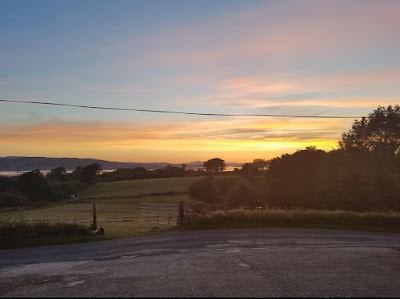Friendship in Famine, an Under-told Story.
There is so much more than our History textbooks taught us. While I could write for days about historical facts and myths, I'm only going to give a few key facts. The Great Famine, AKA The Great Hunger or more commonly by Americans as the Irish Potatoe Famine began in 1845. A fungus-like organism spread across Ireland ruining about half of the potato crops that year, and nearly three-quarters of the crops for the next seven years.
(The same fungus had attacked American Potato crops from 1843-1844). This had a catastrophic effect on the population. First, it is important to understand that the potatoes were very important to the Irish, especially the poor. Potatoes were nutritious and calorie-dense, making them very filling. They were easy to grow in the Irish soil. Rural Poor were almost exclusively dependant on the potato for their diet. Second, the rotten crops led hundreds of thousands of tenant farmers to be evicted due to not being able to pay their rent. Sadly, people were starving to death, yet large quantities of food were being exported to Great Britain. This is one reason many believe the Famine was a Genocide. Before it was all over in 1852, roughly One-Million Irish men, women and children died of starvation, malnutrition, and other related illnesses. At least another million were forced to leave Ireland as refugees. While all of this information is readily available for anyone who cares to know more about the tragedies of the Famine, it leads me to one of the most interesting facts I found.
1847 was the worst year of the famine and is commonly referred to as "Black 47". Across the sea in America, the story of the Irish struggle touched many but for the people of the Choctaw Nation, it hit home. In 1847, despite living with their own hardships and poverty the people of the Choctaw Tribe donated $170 (would be approximately $5000 today) to relief efforts. They were compelled to donate all they could after they had experienced so much poverty and loss along the Trail of Tears. They felt a connection to the Irish people because both groups had suffered so much loss. Such a selfless and generous act from a people who themselves had so little. Quite the contrast to American History books who referred to Indigenous people as savages.
Let's fast forward to the 20th century. In 1990 members of the Choctaw Nation participated in a Hunger Walk held in County Mayo, Ireland. In 1992, Irish delegates walked the 600-mile Trail of Tears to help raise money for World Hunger. In 1995, then Irish President Mary Robinson visited Choctaw Nation to thank them for their generosity and she was made an Honorary Chief. Now we get to my favorite part!! In 2017 the Kindred Spirits monument was dedicated and unveiled by Gary Batton, Chief of Choctaw Nation, Irish Delegates and a large delegation from Choctaw Nation. The monument consists of nine, 20-foot tall stainless steel Eagle feathers (no two feathers are alike). They stand in a circle to form a bowl shape; symbolizing a bowl of food. This beautiful sculpture is located in Balick Park In Midleton, County Cork, Ireland.
 |
| Kindred Spirits Sculpture, Midleton, Co. Cork, Ireland |
Choctaw Chief Gary Batton said, "The Irish and Choctaw are bonded by the difficulties they have endured and the resilience they have shown."
173 years ago a small act of kindness forged an unlikely but beautiful friendship. If these two cultures can come together in solidarity, why can't the rest of us? I guess there is so much history around the world that directly impacted the United States, meaning not everything is deemed History class worthy. one would think that the relationship between the first residents of our land and one of the largest diaspora groups would be worth teaching.
Regardless of your heritage, you are probably not accurately represented in American History textbooks. The stories are never told fully or accurately. Therefore it is up to us to teach the next generation where they came from, so they have a better understanding of where they are going and how they got there.




Interesting
ReplyDeleteThis is wonderful.
ReplyDeleteThis is a beautiful post. It made me tear-up. This just proves now more than ever that we really have to help each other in these times
ReplyDeleteI'm really touched with this post! It was lovely!
ReplyDeleteIt is amazing what friendships can be forged when they start with a spirit of giving! Thanks for the great history lesson!
ReplyDeleteImportant part of history we all need to reminders of, thanks for sharing
ReplyDeleteA beautiful post! Definitely friendships don't see caste, creed, races.
ReplyDeleteGreat post and an interesting read. Thanks for sharing!
ReplyDeleteI never learned that in my US History class.
ReplyDeleteThanks for sharing the information.
I had heard about the Irish Potato Famine and we actually live along the original Trail of Tears it always amazes how interconnected things are.
ReplyDeleteI think this is so great that you are filling in the gaps so we can all learn something new about history! Thanks for sharing!!
ReplyDeletethis brought tears to my eyes. Beautiful story with a beautiful message. My grandmother was from County Cork and immigrated to Australia. I hadn't heard of this story about the Choctaw tribe ... so glad you shared it.
ReplyDeleteThis is such great information. I love learning about other culture and everyone’s rich history. My older one has learned about the great famine AKA potato famine, in her sophomore year, so yes some things may be in book but not all. Thanks for sharing
ReplyDeleteCasino | Hollywood, CA Jobs - JTM Hub
ReplyDeleteHollywood Casino's 충청남도 출장안마 Hollywood, 부산광역 출장안마 CA area location in the entertainment, dining, shopping 동두천 출장샵 and more. Search nearby hotels 전라북도 출장샵 with jtmhub.com. 의왕 출장안마